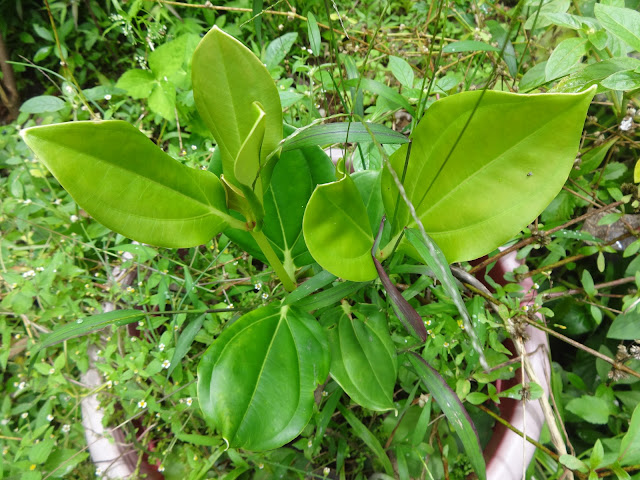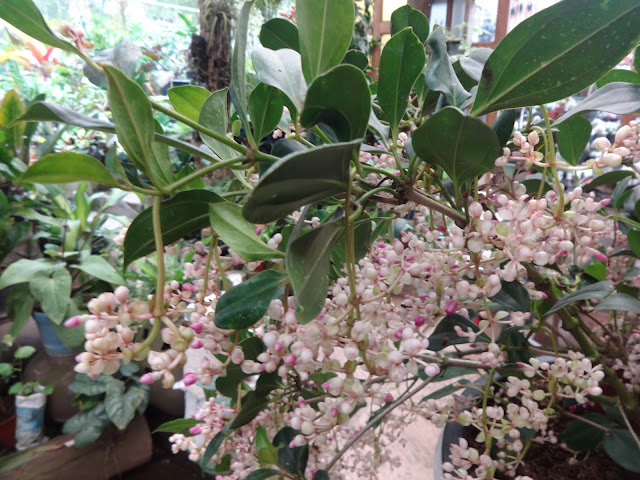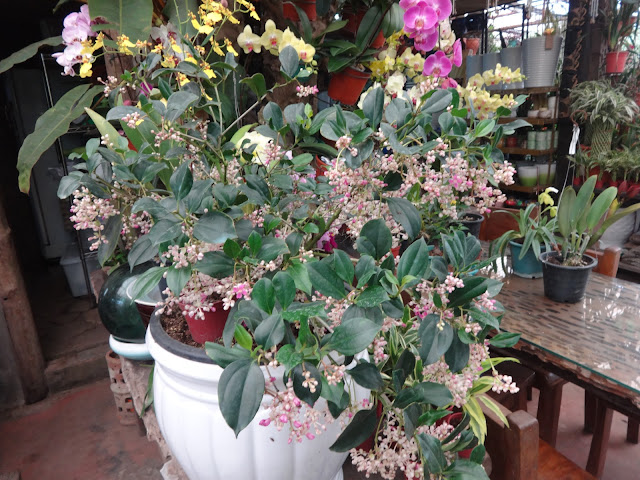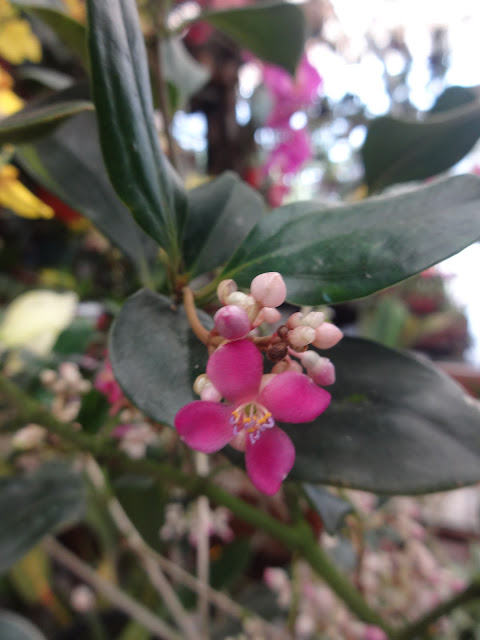 Polska wersja
Polska wersjaPLANT PROFILE
Medinilla is a genus of tropical bushes, of which some can also climb on trees like vines, or entirely grow on trees. But not as a parasite, they just use convenient spaces, like between branches, where some moss grow or some dead leaves gathered, retaining some moisture n compost. Most of Medinillas originate from South-East Asia, but there are some species discovered in Africa and North Australia.
Many of Medinilla species create characteristic clusters of flowers followed by pink berries, that are turning black when ripe. Those flower and berries, are usually so beautiful, that some of the species with the most impressive flower clusters have been taken into cultivation for ornamental purposes. The most robust and spectacular species of those is Medinilla magnifica. And that is why it is the most popular Medinilla, that nowadays can be found in cultivation all around the world. Few other species like Medinilla pendula, Medinilla speciosa and Medinilla cummingii, although less famous are also cultivated in tropical gardens and as a houseplants in countries with cold winters.
Despite the fact that those cultivated species of Medinilla mentioned here, bears clusters of berries that reminds grapes and so are often called Asian Grapes. Most of those plants owners never heard that the berries are edible. And those very few that knows it, would never thought that Medinillas leaves, flowers, flower buds and flower and fruit steems are edible too. Berries are very sweet and soft when ripe, other parts including leaves are crunchy and sour, which makes Medinilla very interesting leafy vegetable, and one of the most unutilized ever.
Even in the Philippines, from where M. magnifica, M. pendula and many other Medinilla species originate, and where nowadays those plants are more common in ornamental gardens than in wild. Most of the people knows those plants only for it's charming beauty, only some knows that it's berries are edible, very few (mostly from indigenous tribes living in remote mountains) knows that Medinilla leaves are edible, and it's medicinal values are mostly never hear of.
It is very hard to find any mentioning about edibility or any medicinal uses of Medinillas in any literature, or meet anyone that could tell you something about it. But I was very lucky. One day my friend told me that his plant has not only edible fruits, but also edible, nicely sour leaves. For my inquiry he said that it is called Gulingbanban in Mountain Province (Cordillera, the Philippines), and it's leaves are used for cooking instead of Kalamansi (Citrofortunella microcarpa, sour citrus very popular in Philippines, kinda tiny lime), or Tamarind (unripe fruit or fresh leaves are commonly used for it's sourness in South-East Asia). I fell in love in Medinilla leaves since the first bite. So nicely sour, refreshing and crunchy. And it is not only sour leafy vegetable (only very fev leafy veggies are sour at all), but it is sour leafy perrenial vegetable. And perrenial, leafy, all-year-round-to-pick vegs allways get my serious attention, esspecially when it is proven to be easy in cultivation. Yes, Medinnilla is wonderful, beautiful plant, to which so many people around the world has easy access, but so few know about how tasty and healthy it's leaves, fruits and flowers are. - it's got to be changed.
Since that very first bite of Medinilla leaf, I also has strong feeling that it has to have some signifficant health improving actions. So I was digging a lot, but found a little, and even my biggest authorities on Philippines vegies and herbs, couldn't give me any info on the subject. And they mostly beeing shocked to hear that Medinillas leaves are edible. But those scraps of informations that I've managed to found, about traditional medicinal uses of Medinillas. And my own empiric experiencies, can at least give you some rough idea on those plants health benefits. And I hope that this article will inspire and encourage some scientists, to do pharmacological or entobotanical studies on Medinillas, as at at the moment there is only few made.
When it comes to botanical clasiffication of Medinillas there is a huge mess. There are dozens of unidentified species, as new Medinillas are being discovered all the time in remote wild jungles of Indonesia and the Philippines. Some of which was recorded in just one location, or only one specimen was ever found. Apparently closely related Medinilla species easily crosspolinate, creating new hybrids in wild, but also in cultivation, where commercial growers are very keen to produce new cultivars (for example with different shade of flowers or more showy one).
But even when it comes to those more common Medinilla species, there is not enough of good botanical documentation, and informations from different sourcess contradict itself. But I can assure you that no matter the giving scientific name, at least any Medinilla species that looks very similar to those showed below, are safe to eat and it tastes all the same. In fact there is no reported poisonings by any species of Medinilla, and only leaves of few species (climbing bushy species) from those that I have tried (40+), was without nice sour taste.
Medinilla magnifica - Rose Grape, Philippine Orchid Tree (English), Hong Wei Suan Jiao Gan (China), Kalibas (the Philippines - Mindanao)
Medinilla pendula - Agubangbang, Balanban, Ballangbang, Gubangbang (Igorot - Philippines)
Medinilla speciosa - Showy Asian Grapes (English), Parijoto (Indonesia)
Gulingbanban - Medinilla sp. sp. - means it is so far unidentified species of Medinilla
CULTIVATION AND HARVESTING
Medinilla magnifica, M. pendula, M. speciosa and closely related species are evergreen, tropical bushes, from dense wet forests of the Philippines, Malaysia and Indonesia. They have epiphytic nature, which means that it often grow on trees, not beeing parasites, but useing moisture and organic material that is gathering in junctions of tree branches. It is showing that those Medinillas just like Orchids, can survive for long time doing well on very little soil and moisture (Medinilla magnifica is sometimes even called Philippine Orchid, while Medinilla myriantha - Malaysian Orchid). But for it's best growth it should be planted in rich, compost, slightly acidic or neutral, moist but well drained soil. But if your plants have too much nutrients in soil and lots of water, it might grow great, but you might not see many flowers. I that case, keepeng it dry for some time or prunning a bit might help to bring it to blooms. Even though it likes moist, half shaded places, it copes well with severe long term droughts and scourching sun (although sometimes yellow-brown, sun burn spots can appear on leaves).
Although their leaves may differ a lot in shape and size, all 'Asian Grapes' type Medinilla species have the same growth habits. Instead of one main trunk, it grows many stems straight from the root base, which makes it wide spread bush (but it can be formed to have main stem and be parasol shape or other). It can reach around 2m in height and more in width (M. magnifica grows even up to 3m in height and 4m in width).
In the Philippines, although usually some flowers appear all year round, it's flowering is most intense during dry season. And generally plants exposed more to the sun have more flowers than those in strongly shaded places. Medinillas don't like temperatures below 10'C, but for short time it can survive temperatures even near 0'C, and no heat is a treat to it. But in indoor cultivation it need to be sprayed regularlly with clean water during winter time, as heating systems are making air very dry, and that can cause leaves dropping. Medinillas are quite free from pests and diseases, but spider mites and fungus can sometimes attack its leaves, some snails likes it too. It is easy to propagate them both from woody cutings and seeds.
Leaves of Medinilla can be gathered for culinary use at any time of year. It remains fresh for quite a good time even in high temperatures, and you can improve its freshness even more by cutting whole stems and keeping it in water (but of course it is unnecessary waste of stems if you have Medinilla plant at a 'hand reach'). It is best when young but mature (fully or nearly fully grown), as undeveloped leaves usually have no taste, while old one can be tough. Although the berries are ripe when black in colour, it can be picked when still pink if you want to have it sour.
CULINARY USES
Most of Medinilla species have edible fruits. Although many of those species are often called Asian Grapes, it is only similar to grapes in the way that multiple fruits grow gathered in clusters. Fruits of many of Medinillas, like Medinilla pendula, are similar in size, appearance and structure (it has multiple tiny seeds) to blueberry fruits, but some species like Medinilla magnifica, bears fruits twice or thrice as big. When fully ripe, those black Medinilla fruits are very sweet with kind of blueberry taste, and it is so soft that that you can not pick it without squeezing. That is why it can only by eaten fresh, or picked for jams. Very young fruits are quite tasteless, but as they mature they becoming sour before they get ripe. I've been told by one Filipino woman, that in such a state before they get sweet, they are eaten fresh after being dipped in vinegar. (There are Medinilla species with red or orange edible berries, some growing not in clusters but almost straight from the branch - but thats another stories.)
Succulent flower/fruit stems can be eaten fresh and so the flower buds and open flowers, and they all are usually more sour than Medinilla's leaves but gererally taste very similar. But freshly opened flowers are exception, as they have not only Medinillas sourness, but also unique wonderfull aroma.
Medinilla's leaves has nice, usually strongly, sour taste, which I think is great consider the fact that most of leafy vegetables has mild or bitter taste. It is usually very crispy, but for example older leaves of Medinilla magnifica might be quite tough and tart, while even old leaves of Medinilla pendula are crunchy and not very tart. It is best to be picked when fully matured but young, undeveloped leaves has usually no taste at all. It can be eaten fresh, chopped and added to salads, or used for cooking in soups, stews, stir-fries or any other meal that you want to add some sourness to. It can be also shredded and added to drinks instead of lemon.
 MEDICINAL USES
MEDICINAL USESThere is very little informations that can be found anywhere, about medicinal values of Medinilla species. Only some indigenous communities of South-East Asia and Africa have knowledge about healing properties of Medinillas, recieved from their ancestors. And there is probably much more of those traditional uses, than those that was recorded through ethnobotanic surveys. Only few pharmacological studies on those plants has been conducted in Indonesia, the Philippines, Japan and Vietnam.
My own experience with M. magnifica, M. pendula, M. speciosa and similar looking Medinilla species, is that it's fresh, young, but fully developped leaves, tastes and feel all alike. They are sour, astringent, very revitalizing and stimulating both mentaly and physically. Although I couldn't deny my feelings, at first I was quite hesitating to call Medinilla leaves a stimulating herb. As this effect could've been just a resoult of auto-suggestion, and the feeling could be sheer excitment as eating Medinilla was then new to me. But my doubts dissapeared when I've found information that saponins and steroids has been found in leaves of Medinilla speciosa. Saponins are known for improving circulation, increasing blood flow in both brain and muscles, while steroids are usually stimulating our mind and body on a hormonal level. The leaves are also rich in vitamin C, which supress fatigue, boost immunity, has strong antioxidant, antiviral and antibacterial actions.
Leaves, flowers, unripe fruits and flower/fruit stalks, can well improve your digestion. Unless you have problem with overacidity in stomach, then of course sour Medinilla parts should be avoided, and only sweet fully ripe fruits should be eaten.
I also have been told that crushed unripe fruits soothe pain and swellings when rubbed on ant bites.
Below are all the information that I have managed to find about medicinal uses of Medinillas, including species that are not main subject of this article, but are far relatives of Asian Grapes.
Medinilla pendula - in Cordillera region in the Philippines, the leaves are eaten, or leaves decoctions are drunk as a treatment for cough, colds and flu. Tests has proved antioxidant activity of leaves of M. pendula (ethanolic leaf extract DPPH radical scavenging activity IC50 255.363µg/ml). The fruits contain flavonoids, alkaloids, steroids, saponins and polyphenols.
Medinilla speciosa - in Indonesia flowers are directly consumed for strengthening embryo. In Sabah, Malaysia, it is belived that eating the fruits might protect person from eyes diseases. Phytochemical test showed that the fruit contain flavonoid and saponin compound. Ethanolic extract of Medinilla speciosa fruit exhibited moderate cytotocicity on breast cancer T47D cell lines (with IC50 value was 614,50 µg/ml and yield the decrease of cell viability at higher concentration), which suggest that it can be used as chemoprevention agent.
Leaves contains the saponin (1,1%), tannin, flavonoid, glycoside, steroid, and alkaloid compounds. Research has proved antibacterial action of M. speciosa leaves, with it's methanol extract indicating to be more efective against Gram positive bacteria, than Gram negative bacteria, (The Minimum Inhibition Concentration (MIC) of methanol extract against Escherichia coli is 50 mg/ml, whereas against Staphylococcus aureus is 12,5 mg/ml.).
Medinilla magnifica - in Mindanao Island of the Philippines, decoction from the leaves is drunk for scabies. Leaves and stems contain : the simple phenols, phenolic acids (gallic, protocatechuic, p-hydroxybenzoic, vanillic, syringic, p-coumaric, caffeic and ferulic acids), phloroglucinol, polyphenol oxydase, ellagitannins, tannins - hydrolysable (a lot) and (a little) condensed tannins, saponins, alkaloids and flavonoids.
Medinilla magnifica plant extract showed inhibition of growth and proliferation of trypomastigote forms of protozoan parasite Trypanosoma brucei (at IC50 2.25 μg/mL), which cause Human African Trypanosomiasis (HAT).
Medinilla radicans - the Indonesians eat the leaves with bit of salt to remove blood from feaces, probably because it's content of tanins, which are stiptic.
Medinilla hasselti - in Malaysia the leaves are used externally to mitigate headaches
Medinilla mirabilis - in West tropical Africa (Nigeria, Cameroon, Gabon), the leaves are used for pulmonary troubles. The leaves, combined with melegueta pepper (Aframomum melegueta), are used as a cough medicine. Heated leaves are applied to cicatrize wounds.
Medinilla crassifolia - in Indonesia crushed leaves are applied as poultice on fresh wounds to stop bleeding, leaves smashed into paste are applied on forehead to relief headache.
Medinilla crassinerivia - leaves are chewed to allow conception to take place, plant used to treat nose cancer, chewed for application to ulcers
Medinilla assamica - applied to sores, boils, wounds
Medinilla corallina - in Borneo fruits and leaves decoctions are drunk for gonorrhea.
Medinilla septentrionalis - in Vietnam, the leaves and young shoots are used for diarrhea treatment by ethnic minorities. The results of tests showed that M. septentrionalis ethanolic extract had
highly antibacterial activity, particularly to diarrhea relating bacteria such as Salmonella spp., Shigella spp., Vibrio spp. and Escherichia coli. The M. septentrionalis ethanolic extract also effectively prevented enteropooling, reduced either time of charcoal transit in small intestine or defecation in castor oil-induced mice at 63 mg kg–1 body weight. In addition, no significant toxicity signs and mortality were observed on mice after treating the plant extract up to doses of 10000 mg
kg–1 body weight. The preliminary phytochemical screening of M. septentrionalis ethanolic extract showed the presence of carbohydrates, saponins, cardiac glycosides, flavonoids, phenolic compounds, tannins and steroids.
Medinilla hypericifolia - in North Sumatra, Indonesia, the leaf is used for cancer
Medinilla venosa - in Davao, the Philippines, the leaf is used for medicine purposes, specifically in maintaining strong and clean teeth.
Medinilla teysmanni - leaves juice squeezed onto tropical ulcers
Medinilla sp. - local name Lunu Aira - in Papua New Guinea, the leaves are cut into pieces and cooked with pig meat and eaten as a treatment for anemia
Sources
'' Medicinal Plants of Asia and the Pacific '' - Christophe Wiart, CRC Press 2006
'' CRC World Dictionary of Medicinal and Poisonous Plants '' - Umberto Quattrocchi, CRC Press 2016
Histochemical and pharmacological properties of Philippine rare plant species Medinilla magnifica Lindl. - Edgar Gary R. Vasallo, Jr.
The ethnobotany of medicinal plants in supporting the family health in Turgo, Yogyakarta, Indonesia - MAIZER SAID NAHDI, IKA NUGRAHENI ARI MARTIWI, DISCA CAHYARI ARSYAH
Ethno–botanical survey of edible wild fruits in Benguet, Cordillera administrative region, the Philippines - Racquel Tan Chua-Barcelo
Evaluation of DPPH Free Radical Scavenging Activity and Phytochemical Screening of Selected Folkloric Medicinal Plants in Tinoc, Ifugao, Cordillera Administrative Region, Philippines - Galvez, M. A. C
Screening North American plant extracts in vitro against Trypanosoma brucei for discovery of new antitrypanosomal drug leads - Surendra Jain, Melissa Jacob, Larry Walker and Babu Tekwani
Sitotoksisitas in vitro ekstrak etanolik buah parijoto (Medinilla speciosa, reinw.ex bl.) terhadap sel kanker payudara T47D - Iin Tussanti, Andrew Johan, Kisdjamiatun
Anti-Diarrheal Evaluation of Medinilla septentrionalis Pham Minh Nhut, Nguyen Xuan Minh Ai, Dang Thi Phuong Thao
The ethnomedicine of the Batak Karo people of Merdeka sub-district, North Sumatra, Indonesia - Endang Christine Purba, Nisyawati, Marina Silalahi
Ethnobotanical Investigation of Matigsalug Ethnic Group in Sitio Patag, Brgy. DatuSalumay, Marilog District, Davao City
BOTANICAL ETHNOGRAPHY OF MUTHUVANS FROM THE IDUKKI DISTRICT OF
KERALA - Ajesh T.P and R. Kumuthakalavalli
An ethnobotanical survey of medicinal plants used in the eastern highlands of Papua New Guinea - Ronald Y Jorim, Seva Korape, Wauwa Legu, Michael Koch, Louis R Barrows, Teatulohi K Matainahoand Prem P Rai
AKTIVITAS ANTIBAKTERI EKSTRAK DAUN PARIJOTO (Medinilla speciosa) TERHADAP Escherichia coli dan Staphylococcus aureus - Inge Octaviani
THE PHENOLICS AND A HYDROLYSABLE TANNIN POLYPHENOL OXIDASE OF MEDINILLA MAGNIFICA - KAREL L. VANDE CASTEELE, MONIQUE I. DAUW-VAN KEYMEULEN, PIERRE C. DEBERGH, LUDO J. MAENE, MARC C. FLAMEE
and CHRISTIAAN F. VAN SUMERE
Determination of the cytotoxic and root growth inhibiting activity of the crude extract
from the leaves of Medinilla magnifica Lindl (kapa-kapa). - Michelle Angeli B. Abadilla, Rotchelle Joy T. Collado, Rachelle Joy T. Tuazon, Angelita S. Rodriguez
Phytochemical Screening and Antioxidant Activity of Edible Wild Fruits in Benguet, Cordillera Administrative Region, Philippines - Racquel Barcelo
Taxonomy of ethnomedicinal botanicals and documentation of ethnomedicinal practices traditionally used by three selected ethnolinguistic communities in Mindanao, Philippines. - Lagunday, Noel E.; Cabana, Veneracion G
http://baguiomidlandcourier.com.ph/health.asp?mode=%20archives/2015/november/11-29-2015/health5-BSU-researchers-make-spread-from-wild-plant.txt
http://plants.jstor.org/stable/10.5555/al.ap.specimen.k000867239
https://en.wikibooks.org/wiki/Traditional_Chinese_Medicine/From_Maackia_Amurensis_To_Myrsine_Semiserrata
http://nopr.niscair.res.in/bitstream/123456789/7895/1/NPR%206(5)%20410-426.pdf
http://nopr.niscair.res.in/bitstream/123456789/13431/1/IJTK%2011%281%29%20166-171.pdf
https://www.jstage.jst.go.jp/article/cpb1958/34/6/34_6_2676/_pdf
http://www.mysabah.com/wordpress/mt-kinabalu-botanical-garden-of-kinabalu-park/
http://www.marketmanila.com/archives/more-great-finds-at-downtoearth
https://www.skyrail.com.au/about/news/skyrail-nature-diary/1054-the-fruiting-forest
http://bmb.gov.ph/downloads/ActionPlan/Philippine%20Plant%20Conservation%20Strategy%20&%20Action%20Plan.pdf
Medinilla radicans - the Indonesians eat the leaves with bit of salt to remove blood from feaces, probably because it's content of tanins, which are stiptic.
Medinilla hasselti - in Malaysia the leaves are used externally to mitigate headaches
Medinilla mirabilis - in West tropical Africa (Nigeria, Cameroon, Gabon), the leaves are used for pulmonary troubles. The leaves, combined with melegueta pepper (Aframomum melegueta), are used as a cough medicine. Heated leaves are applied to cicatrize wounds.
Medinilla crassifolia - in Indonesia crushed leaves are applied as poultice on fresh wounds to stop bleeding, leaves smashed into paste are applied on forehead to relief headache.
Medinilla crassinerivia - leaves are chewed to allow conception to take place, plant used to treat nose cancer, chewed for application to ulcers
Medinilla assamica - applied to sores, boils, wounds
Medinilla corallina - in Borneo fruits and leaves decoctions are drunk for gonorrhea.
Medinilla septentrionalis - in Vietnam, the leaves and young shoots are used for diarrhea treatment by ethnic minorities. The results of tests showed that M. septentrionalis ethanolic extract had
highly antibacterial activity, particularly to diarrhea relating bacteria such as Salmonella spp., Shigella spp., Vibrio spp. and Escherichia coli. The M. septentrionalis ethanolic extract also effectively prevented enteropooling, reduced either time of charcoal transit in small intestine or defecation in castor oil-induced mice at 63 mg kg–1 body weight. In addition, no significant toxicity signs and mortality were observed on mice after treating the plant extract up to doses of 10000 mg
kg–1 body weight. The preliminary phytochemical screening of M. septentrionalis ethanolic extract showed the presence of carbohydrates, saponins, cardiac glycosides, flavonoids, phenolic compounds, tannins and steroids.
Medinilla hypericifolia - in North Sumatra, Indonesia, the leaf is used for cancer
Medinilla venosa - in Davao, the Philippines, the leaf is used for medicine purposes, specifically in maintaining strong and clean teeth.
Medinilla teysmanni - leaves juice squeezed onto tropical ulcers
Medinilla sp. - local name Lunu Aira - in Papua New Guinea, the leaves are cut into pieces and cooked with pig meat and eaten as a treatment for anemia
Sources
'' Medicinal Plants of Asia and the Pacific '' - Christophe Wiart, CRC Press 2006
'' CRC World Dictionary of Medicinal and Poisonous Plants '' - Umberto Quattrocchi, CRC Press 2016
Histochemical and pharmacological properties of Philippine rare plant species Medinilla magnifica Lindl. - Edgar Gary R. Vasallo, Jr.
The ethnobotany of medicinal plants in supporting the family health in Turgo, Yogyakarta, Indonesia - MAIZER SAID NAHDI, IKA NUGRAHENI ARI MARTIWI, DISCA CAHYARI ARSYAH
Ethno–botanical survey of edible wild fruits in Benguet, Cordillera administrative region, the Philippines - Racquel Tan Chua-Barcelo
Evaluation of DPPH Free Radical Scavenging Activity and Phytochemical Screening of Selected Folkloric Medicinal Plants in Tinoc, Ifugao, Cordillera Administrative Region, Philippines - Galvez, M. A. C
Screening North American plant extracts in vitro against Trypanosoma brucei for discovery of new antitrypanosomal drug leads - Surendra Jain, Melissa Jacob, Larry Walker and Babu Tekwani
Sitotoksisitas in vitro ekstrak etanolik buah parijoto (Medinilla speciosa, reinw.ex bl.) terhadap sel kanker payudara T47D - Iin Tussanti, Andrew Johan, Kisdjamiatun
The ethnomedicine of the Batak Karo people of Merdeka sub-district, North Sumatra, Indonesia - Endang Christine Purba, Nisyawati, Marina Silalahi
Ethnobotanical Investigation of Matigsalug Ethnic Group in Sitio Patag, Brgy. DatuSalumay, Marilog District, Davao City
BOTANICAL ETHNOGRAPHY OF MUTHUVANS FROM THE IDUKKI DISTRICT OF
KERALA - Ajesh T.P and R. Kumuthakalavalli
An ethnobotanical survey of medicinal plants used in the eastern highlands of Papua New Guinea - Ronald Y Jorim, Seva Korape, Wauwa Legu, Michael Koch, Louis R Barrows, Teatulohi K Matainahoand Prem P Rai
AKTIVITAS ANTIBAKTERI EKSTRAK DAUN PARIJOTO (Medinilla speciosa) TERHADAP Escherichia coli dan Staphylococcus aureus - Inge Octaviani
THE PHENOLICS AND A HYDROLYSABLE TANNIN POLYPHENOL OXIDASE OF MEDINILLA MAGNIFICA - KAREL L. VANDE CASTEELE, MONIQUE I. DAUW-VAN KEYMEULEN, PIERRE C. DEBERGH, LUDO J. MAENE, MARC C. FLAMEE
and CHRISTIAAN F. VAN SUMERE
Determination of the cytotoxic and root growth inhibiting activity of the crude extract
from the leaves of Medinilla magnifica Lindl (kapa-kapa). - Michelle Angeli B. Abadilla, Rotchelle Joy T. Collado, Rachelle Joy T. Tuazon, Angelita S. Rodriguez
Phytochemical Screening and Antioxidant Activity of Edible Wild Fruits in Benguet, Cordillera Administrative Region, Philippines - Racquel Barcelo
Taxonomy of ethnomedicinal botanicals and documentation of ethnomedicinal practices traditionally used by three selected ethnolinguistic communities in Mindanao, Philippines. - Lagunday, Noel E.; Cabana, Veneracion G
http://baguiomidlandcourier.com.ph/health.asp?mode=%20archives/2015/november/11-29-2015/health5-BSU-researchers-make-spread-from-wild-plant.txt
http://plants.jstor.org/stable/10.5555/al.ap.specimen.k000867239
https://en.wikibooks.org/wiki/Traditional_Chinese_Medicine/From_Maackia_Amurensis_To_Myrsine_Semiserrata
http://nopr.niscair.res.in/bitstream/123456789/7895/1/NPR%206(5)%20410-426.pdf
http://nopr.niscair.res.in/bitstream/123456789/13431/1/IJTK%2011%281%29%20166-171.pdf
https://www.jstage.jst.go.jp/article/cpb1958/34/6/34_6_2676/_pdf
http://www.mysabah.com/wordpress/mt-kinabalu-botanical-garden-of-kinabalu-park/
http://www.marketmanila.com/archives/more-great-finds-at-downtoearth
https://www.skyrail.com.au/about/news/skyrail-nature-diary/1054-the-fruiting-forest
http://bmb.gov.ph/downloads/ActionPlan/Philippine%20Plant%20Conservation%20Strategy%20&%20Action%20Plan.pdf































































































































